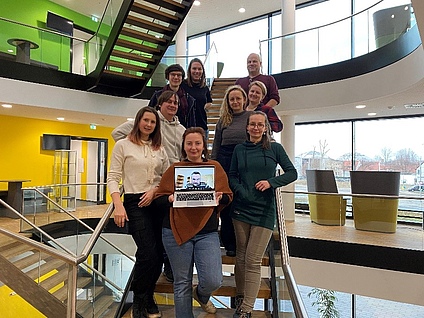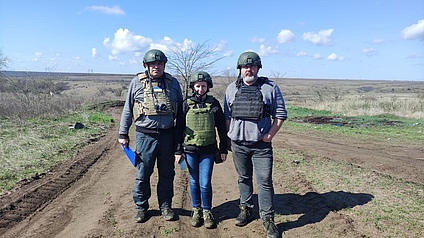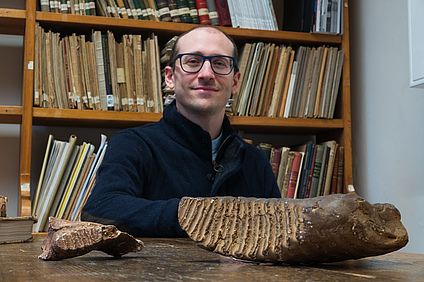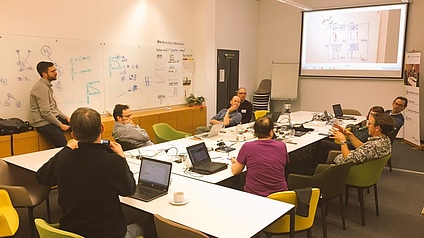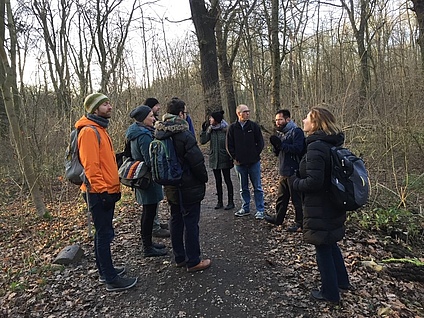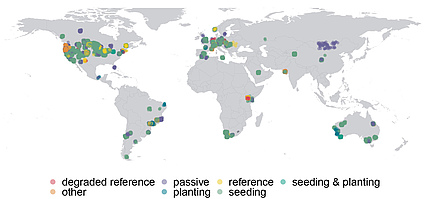Editorial
Is synthesis still successful and needed?
In the last year we in sDiv and our home centre iDiv went through many strategic discussions and revisions of our scientific mission and goals. We will enter a completely new funding phase from October 2024 onwards and wanted to revise our underlying aims and goals. This is an ongoing process of redefining what iDiv and with it sDiv, plans to do in future. Inspiring but also not easy after 10 years establishing a very successful centre. We will move from a 12 year period of generous 3rd party funding from our German Research Foundation (DFG) to direct and indirect funding from our hosting Federal states (Saxony, Saxony-Anhalt & Thuringia) and three universities (Martin-Luther University in Halle, Saxony-Anhalt, Leipzig University in Saxony and Friedrich-Schiller University in Jena, Thuringia) as well as continued funding from the Helmholtz Centre for Environmental Research - UFZ.
I want to start (well, we’re half way in already, so not really a start) this year's sDiv newsletter editorial with parts of the mentioned newly revised and sharpened sDiv mission statements.
“sDiv, iDiv’s synthesis centre, provides global leadership on synthesizing knowledge of biodiversity change, its underlying processes and consequences for the functioning of ecosystems. We want to understand the complexity of ecological processes and to design effective actions to protect and sustain our natural world. We accomplish synthesis through a diversity of research activities.
We currently support and envision maintaining (1) working groups, in which diverse groups of scientists come together to pool their knowledge and skills and to produce synthetic results and understanding, regularly supported by (2) synthesis postdocs, which are the best dedicated young researchers from around the world, and (3) more flexible synthesis projects allowing a combination of personnel and meeting approaches.”
[See for more insight in (1) an insight story on how diversity and comfort zones play a role; and for (3) an insight here.]
The revised mission statement perfectly describes the work and focus of sDiv in the last few years and our plans for the next few years. For example, in the last three calls we successfully focussed on supporting research relevant for and researchers from research-wise underrepresented regions. Under this regional focus we funded 13 flexible synthesis projects and two postdocs, adding researchers from seven research-wise underrepresented countries to our participant network. We also supported early career researchers (ECR) in different ways. We have a synthesis postdoc program and we support ECR working groups. With these working groups we provide an opportunity for ECRs to lead collaborative projects in a setting of smaller teams not dominated by senior researchers. Since the implementation of that program, we funded eight working group projects, led and mainly driven by early career researchers.
And now coming to the initial question: Is synthesis successful and still needed? I obviously have a strong COI here but that’s ok I guess, because it’s my section to tell you about my personal opinions and thoughts. And yes, we still do need synthesis. Even 28 years after NCEAS was established as the first synthesis centre of its kind, this research approach is needed. The ongoing demand of the research community (visible via the continuing number of proposals not only in sDiv) and also recent developments in other places of the world to open new synthesis research infrastructures (e.g. South Africa) show the success and necessity for synthesis. Our mission text says: “Why synthesis? Synthesis research is still a highly needed research approach (next to many others at iDiv) with the wealth of newly generated data, shifting in the last decade from purely scientific observations and measures to data, generated by even more heterogeneous sources (e.g. citizen science, historic data mobilized by AI, social media, multi-language text & data analyses etc). The ongoing internationalization of the global research community and iDivs efforts offer more opportunities to also support more strongly emerging synthesis efforts, researchers and research questions highly relevant for underrepresented regions. “
I hope it convincingly justifies in a brief way the complex knowledge and information universe we need to use to help answer important research questions. More than ever the global research community has to mobilize old and new knowledge and work together to solve some of the grand challenges of humanity. Synthesis will be one of many helpful approaches in this critical era of our planet.
To support such collaborative team science, projects need to be diverse in many dimensions (incl. research backgrounds, gender, career status, expertise, data etc). And what not only the last Covid years have taught me and many of us is that nothing replaces the interaction depth and creativity created in in-person meetings (see more on it here). We will continue to support international team meetings here at sDiv, being embedded in our now exactly 3 year old great iDiv building. However, this approach creates significant challenges to our activities towards a more sustainable life. For the first time we were allowed to use project funding to compensate the CO2 footprint sDiv creates. We compensated 283 tons of CO2 created by sDiv guests and project participants with their travel to and from iDiv in 2022. Although this can be criticized as selling indulgences, it’s the best way to keep a highly necessary diversity in our synthesis projects as well as compensating a bit of our footprint. We plan to further compensate our CO2 footprint as best as possible in the upcoming years too.
Have a great rest of the year,
cheers from sunny Leipzig
sM(arten Winter, head of sDiv)
sCaleGrassDiv
Identifying drivers and mechanisms of plant diversity change across small spatial scales in Ukrainian grasslands
Grasslands rank among the Earth's most species rich habitats, and at fine spatial scales they can support even greater plant diversity than tropical forests. For example, in steppe grasslands in Ukraine we found 7 species of vascular plants per 1 cm2. Among the central questions are how so many species can coexist in such limited spaces and what governs the spatial variability of species composition among local communities. In our sDiv synthesis project sCaleGrassDiv, co-hosted by iDiv member Jon Chase, we address these questions using data collected from 382 sublots nested within 191 grassland plots located across all grassland habitat types in the Ukraine ranging from saline and dry habitats via wet and mesic grasslands up to alpine grassland types. Some of the grassland types are unique and some are global biodiversity hotspots for grassland vegetation, and thus are particularly important for biodiversity conservation. Covering all these grassland types allows us to test a wide gradients of biodiversity drivers, such as climate gradients and variability, soil properties, and land use. We test the mechanisms for each of these drivers when altering species richness on different grain sizes.
While previous research on spatial variability in plant diversity focuses mainly on vascular plants, our data encompass vascular and non-vascular plants (i.e., lichens and bryophytes), which, as has been shown earlier, respond differently to the environmental gradients. Furthermore, our species list of 1560 plant species includes multiple rare species as well as species endemic to the territory of Ukraine, for which functional traits are not available in the literature and for many of which we have our own measured traits. We will merge our own trait data with the trait data from the literature, to test the drivers of functional diversity and how they differ among scales. Ukraine in general is a strongly underrepresented area in scientific literature, while such spatially well-resolved data as ours has not been published before. Furthermore, our datasets were collected using the same standardized GrassPlot methodology of The Eurasian Dry Grassland Group (EDGG) and thus our results can be compared to the other or similar grassland habitats globally.
We are currently frequently asked how our work is affected by the war in Ukraine. We can say that the war has a significant impact on our team members and on our work. Seven members of our working group are originally from Ukraine and were affiliated with the Ukrainian scientific or academic organizations before the full-scale military invasion of Ukraine by the Russian Federation on February 24 2022. Two of our team members were forced to leave Ukraine after the outbreak of hostilities and currently hold refugee status in the Czech Republic and Switzerland. Another two members were on an internship outside of Ukraine, and due to the full-scale invasion they were unable to return to Ukraine. One of our male colleagues was unable to join the workshop in person due to the ban for men of military age to travel outside of Ukraine. Monitoring our study sites has become challenging and at times unsafe. Some of our permanent monitoring sites are currently temporarily occupied by Russian troops, rendering them inaccessible and preventing us from continuing our research. Furthermore, many vegetation experts had to depart the country as well as the funding for scientific research has been severely constrained. Considering all these circumstances, one can truly appreciate the significance of the sDiv support. It enables our team to meet, to brainstorm and to synthesize our data by bringing together the diversity of expertise. The results from the 1st workshop are in preparation for a publication. Moreover, for certain team members it facilitated research collaboration extending far beyond the scope of the project itself.
Oksana Buzhdygan, Anna Kuzemko
Roberto Rozzi
Diving into the past to investigate the demise of island dwarfs and giants
Chronicles of a paleontologist at sDiv
I have always been fascinated by reconstructing past ecosystems and exploring the potential use of the fossil record to gather information for conservation planning. Thus, right from my PhD days, I have sought to integrate elements of paleoecology, biogeography, and conservation paleobiology into my research. Towards the end of 2018, following the conclusion of my first postdoc project at the Natural History Museum of Berlin, I noticed that iDiv’s synthesis centre sDiv was advertising a postdoctoral call. Intrigued by this opportunity, I decided to apply with a paleo-project. While I was familiar with iDiv as a centre of excellence for biodiversity research and conservation, I was fairly certain that there were no in-house paleontologists (little did I know that I would become the first paleo-postdoc at sDiv). Luckily, stars aligned and I could spend over two years at sDiv investigating how evolution towards dwarfism and gigantism has influenced the risk and rate of extinction of mammals on islands, in collaboration with iDiv Biodiversity Synthesis professor Jonathan Chase and a team of researchers from 10 countries. Jonathan Chase, an expert in biodiversity change across spatial scales, was intrigued by the opportunity to embark on his first venture into the ‘paleo’ side of ecology and shed light on island biodiversity using a unique data set.
The evolutionary “oddities” of island life stand out as some of the most spectacular phenomena in the natural world, yet islands contain a disproportionately higher amount of threatened and extinct biota compared to continents. From dwarf hippos and elephants, deer with bizarre antlers and giant rats - the roster of weird island mammals is vast, both in the fossil record and today. Personally, I have always been captivated by the ecologically naive nature of these taxa. This has motived me to delve into the relationship between their peculiarity and their vulnerability, especially after human colonization. In the main output of the sDiv postdoc project, published earlier this year in Science, we found that the likelihood of extinction and of endangerment are highest in the most extreme island dwarfs and giants. Sadly, our results revealed that extinction risk of insular mammals was compounded by the arrival of modern humans, which accelerated extinction rates more than 10-fold (Rozzi et al., 2023). While new arrivals and faunal turnovers are part of the natural dynamics of island ecosystems, we showed that the effect of the arrival of modern humans and their introduced biotas on global extinction rates of island mammals was unprecedented, at least since the beginning of the Quaternary.
Assembling and synthesizing the most extensive database on extant and fossil insular mammals to date has represented a crucial phase of this project and taught me about the perseverance and time required for synthesis. Throughout the pandemic, while working from home every day, gathering data from hundreds of papers, books, and excavation reports occasionally felt akin to a near-monastic experience. The input of collaborators and the support of two student assistants, Louise Dädlow and Lena Husemann, funded by sDiv, were of great help during this phase of the project, which spanned nearly two years. In total, we compiled data on extinction risk, body mass and body size shifts of 1231 extant species and 350 extinct species of insular mammals. Moreover, we assembled a dataset of >7800 fossil occurrences from over 1400 sources representing 182 islands and paleo-islands worldwide spanning 23.03 Ma (Rozzi et al., 2023). While the data mobilization work of the students may not have always been particularly exciting due to its repetitive nature, both students were integral parts of the sDiv team and are now pursuing careers in science, partially still within the iDiv consortium.
Despite the challenges posed by the pandemic, my time at iDiv has been an incredibly rewarding experience. Virtual lab meetings, coffee breaks, and various other initiatives have allowed us to stay connected and fostered networking opportunities even while confined to our homes. As the situation gradually improved, these connections blossomed into fruitful collaboration. For instance, I was part of a team that reviewed the effects of many types of scale in detecting ecological thresholds (Spake et al., 2022) and I had the opportunity to contribute to a study that assessed global species abundance distributions of Eukaryotes (Callaghan et al., 2023). Furthermore, data gathered for the sDiv postdoc project laid the foundation for collaboration with other fellow island-enthusiasts at iDiv investigating the distribution of palms in Madagascar and the evolution of insular woodiness (Méndez et al., 2022; Zizka et al., 2022). Finally, being exposed to so much inspiring research in ecology and biodiversity science and having the opportunity to receive feedback and learn from colleagues across different research labs, particularly those in sDiv and Biodiversity Synthesis, have greatly benefited my paleontological research.
Earlier this year I joined the Central Repository of the Natural Science Collections (ZNS, in German only) at Martin Luther University Halle-Wittenberg as Curator of Paleontology. As thrilled as I am to return to collection-based work, conservation paleobiology and synthesis will continue to play a pivotal role in my research. ZNS is part of iDiv’s unique science consortium and I am excited about the prospect of further collaborations.
Roberto Rozzi
Cited literature
Méndez, L. et al. (2022). Megafrugivores as fading shadows of the past: extant frugivores and the abiotic environment as the most important determinants of the distribution of palms in Madagascar. Ecography, 2022(2).
Spake, R. et al. (2022). Detecting thresholds of ecological change in the Anthropocene. Annual Review of Environment and Resources, 47, pp.797-821.
Zizka, A. et al. (2022). The evolution of insular woodiness. Proceedings of the National Academy of Sciences, 119(37), p.e2208629119.
Rozzi, R. et al. (2023). Dwarfism and gigantism drive human-mediated extinctions on islands. Science, 379(6636), pp.1054-1059.
Callaghan, C.T. et al. (2023). Unveiling global species abundance distributions. Nature Ecology & Evolution, pp.1-10.
News from other synthesis centres
SESYNC
Greetings from the National Socio-Environmental Synthesis Center (SESYNC)! While we are closed to supporting new synthesis teams, we have been busy developing open-access resources on topics related to both interdisciplinarity and sustainability. These are great for self-learning and training. Below are just a few examples. The video tutorials are developed by researchers and are professionally videographed! Please use the resources and share with colleagues. Click here to receive SESYNC newsletters.
Margaret Palmer
Modeling – great for graduate students, postdocs, and researchers:
• Network Modeling for Socio-Environmental Systems This tutorial introduces networks and
their use in research.
• Use of Systems Thinking Archetypes This tutorial explains how archetypes can illuminate
coupled socio-ecological dynamics and how they can help in developing formal S-E models.
• Modeling Approaches: What are the Choices and How do we Select one? This explainer
describes the most common types of models with hints on which are best for different goals.
Bridging Disciplines and Fostering Team Research – great for synthesis teams:
• Best Practices for Interdisciplinary Team Research: Shaping a Team’s Social Environment
This explainer provides activities and tips for positively shaping a team’s social environment to
enhance the effectiveness and productivity of collaborations.
• Building an Interdisciplinary Team This explainer addresses some common questions related
to assembling interdisciplinary teams and offers tips based on team science literature and on
SESYNC experiences.
• What Is a Shared Mental Model? Why Are Mental Models Useful for Interdisciplinary Research? This explainer introduces shared team mental models and provides guidance on the
steps in developing these.
Core Concepts in Sustainability – self-learning/teaching for graduate students, postdocs & researchers:
• Sustainability, Resilience, and the Dimensions of Risk: Hazard, Exposure, Vulnerability
This explainer covers: use of “resilience” by ecologists, social scientists, and socio-ecological
systems researchers; and the dimensions of risk. The next resource is a related lesson great for
workshops and classes.
• Introduction to Resilience and Sustainability – Ecological, Social, Socio-Environmental
This lesson merges ecological and social viewpoints to introduce resilience and the dimensions of
risk; it also provides an overview of the diverse perspectives and vast literature on resilience.
• Integrating Spatial Ecology and Resilience Theory to Understand Ecosystem Service Flows Lesson
This lesson is based on research integrating ecological with social benefits by
considering how spatial distributions co-influence ecosystem and social resilience; a guide to
understanding the basics of spatial resilience and applying its insights to a city.
sLandServ
Work in an sDiv group – more than the sum of all parts
What is so special about participating in a sDiv group? What makes different researchers or stakeholders leave their comfort zone and work together in the first place? And what makes these heterogeneous groups stick together afterwards and continue working together? Have you thought about it? If not, follow us just for a few minutes.
We were part of the ‘sLandServ’ group, a working group focused on understanding how landscape structure influences the provision of ecosystem services; i.e., the benefits people receive from nature. This problem is unique, because it requires a strong social-ecological perspective and so bringing together researchers from diverse disciplines is crucial. The sDiv working group allowed us exactly this. To discuss and develop new knowledge about social and ecological processes that generate ecosystem services benefits we met twice for a whole week each time in Leipzig during 2017/18. The meetings allowed environmental, social and economic scientists to come together to study how nature benefits humans in human-modified landscapes and jointly develop new theoretical and methodological approaches to deal with environmental governance at landscape scales (Metzger et al. 2021).
In the end, we were not only interested in our interdisciplinary results, but we were also curious on how we worked together as a group. In particular, we were interested in understanding how the dynamics of synthesis operated as boundary work (Schröter et al. 2023), that is as an active process to connect across the boundaries of the separated domains. So we chose to reflect on this after the workshops and developed a short self-evaluation survey on our interdisciplinary group work and how we were able to bridge separate disciplinary domains.
Diversity, common knowledge & comfort zones
The diversity of our group varied across disciplinary, methodological, and experiential backgrounds. We were 16 invited researchers from seven countries on five different continents. We had been trained in different scientific disciplines, including natural and social sciences, and used different methods for our research. We also were in different stages of our career (a mix of PhD students, Postdocs, and senior scientists). Although English was our working language, it was not the mother tongue of all of us. However, we had something in common. All of us were already working with the ecosystem service concept before participating in the workshop so it supported communication between natural and social scientists. Further, we focused on a method called Social-Ecological Network Analysis (SENA) which was easy to understand for everyone and therefore not only useful for communication amongst us, but which also allowed us to integrate the work of social and natural sciences. SENA thus functioned as a connecting tool, which we call a boundary object and concept (Schröter et al. 2023).
The sDiv workshops were a vital collaborative setting which enabled us to meet in person, apply SENA to our work and discuss new ideas at the interfaces of our knowledge. The ‘sLandServ’ group and workshops operated as a boundary setting, allowing people from different disciplines to work collaboratively together (Schröter et al. 2023). Particularly, it was a suitable setting due to the interdisciplinary and intergenerational composition of the group, as well as the free format which gave enough time and space for open discussions. From the beginning of the process sDiv, the iDiv events team and the workshop organisers were outstanding in providing a conducive environment to bring participants together. But success was also achieved because the participants were willing to leave their comfort zones, and cross their disciplinary and methodological boundaries. Group composition and meeting format, choosing participants strategically and allowing equal contribution from each group member, switching between plenum discussions and smaller breakout groups, were essential to foster collaborative work within our scientific synthesis, making possible creative and associative thinking as well as interdisciplinary scientific collaboration. As we spent a whole week together, all staying in the same hotel, enjoying a well designed excursion programme, not having to worry about organisational stuff such as where to get food and drinks (sDiv and the events team did it all), there was also enough ‘social time’ to really get to know each other as private individuals, creating the necessary ‘glue’ for making us real team mates. We did not only work together, but also had fun with each other.
For future work in research and practice, we identified two important aspects to consider. First, there is a need for more knowledge on how boundary elements (e.g., objects, concepts, settings) can be used to catalyse synthesis initiatives, particularly for social-ecological research. Second, we call for a more formal and explicit consideration of boundary work in the development of synthesis working groups since this approach has great potential to improve the success of these groups.
Recommendations
From our experiences we recommend to take advantage of the concepts of boundary work right from the conception of the synthesis working groups. By explicitly and purposefully incorporating the so-called ‘boundary elements’ – especially a good setting and scientific concepts and objects that foster communication and integration – into the workshop design, the collaborative potential of working groups can be enhanced (if you want to know more, please read our paper: Schröter et al. 2023):
- Boundary setting: Have a good proportion of people from different disciplines of origin, more or less balanced in numbers, to guarantee the integration of ideas (A big imbalance in the number of participants, between social and natural scientists may make it more difficult to cross disciplinary boundaries due to bias towards a particular discipline area. This may be considered at the very beginning of the group formation by paying careful attention to the invited participants’ skills, and by specifically integrating social scientists).
- Boundary concepts: Being familiar with joint concepts, like ecosystem services, before starting the working group helps to start communication among people and makes it easier to find objects for knowledge integration.
- Boundary objects: Developing ‘objects’ (again: please read our paper!) together before organising an event may lower the risk of bringing objects that are specific to only a few disciplines (However, deciding about this aspect before the event is an approach that still needs to be tested).
We hope that the reflection on our work in the ‘sLandServ’ synthesis group will inspire you in further research on how to ensure that synthesis initiatives maximise successful integration across disciplines!
Barbara Schröter, Jean Paul Metzger, Jonathan Rhodes and Claudia Sattler
Cited literature
Metzger, J.P., Fidelman, P., Sattler, C., Schröter, B., Maron, M., Eigenbrod, F., Fortin, M.-J., Hohlenwerger, C., and Rhodes, J.R. (2021). Connecting governance interventions to ecosystem services provision: a social-ecological network approach. People and Nature 3(2):266–280.
Schröter, B., Sattler, C., Metzger, J., Rhodes, J. R., Fortin, M.-J., Hohlenwerger, C., Carrasco, L.R., and Bodin, Ö. (2023). Exploring the role of boundary work in a social-ecological synthesis initiative. J Environ Stud Sci 13, 330–343.
sReStoReS
SynFlex - Insights into a flexible synthesis funding mechanism
The Global Restore Project is our effort to compile community vegetation responses to disturbance, the ending of disturbance, and active ecological restoration treatments such as seeding and planting trees. We want to share knowledge to inform shared success in the United Nations Decade on Ecosystem Restoration. I started out by writing an Alexander von Humboldt Foundation grant application for a 24 month postdoc fellowship, shortly after arriving at iDiv as a Flexpool funded postdoc with Jon Chase and Stan Harpole (Flexpool is iDivs internal funding mechanism to foster collaborations within the consortium). I proposed to ask questions about community assembly and the functioning of ecosystems, as well as look at measurements of biodiversity across scales in disturbed and restored communities and metacommunities.
Shortly after getting started, someone told me that Nancy Shackelford, a postdoc at University of Colorado Boulder, was working on something similar. I reached out, and Nancy explained she was compiling data like this only within the world’s drylands in the Global Arid Zone Project. I proposed to complete the precipitation gradient, and we agreed to collaborate and call our joint collaboration the Global Restore Project. We’ve been embracing the variety of ways that restoration gets done in the field. This means we have collected a variety of datasets that answer a variety of different questions. This also means, compiling and managing these data is a lot of work.
This project successfully has had ongoing support from the Alexander von Humboldt Foundation and Jon Chase’ Biodiversity Synthesis group. Since then, Nancy Shackelford has become an Assistant Professor and Director of the Restoration of Natural Systems Program at University of Victoria in Canada and has been supporting us from there. When sDiv announced their SynFlex funding scheme during the 9th call, this sounded like a scheme that could help support our project. The idea was that SynFlex proposals didn’t have to be a ‘working group’, you could request for a variety of flexible support mechanisms for synthesis projects. Jon Chase and I decided to propose the next phase of our project; to better integrate data from Europe and to begin networking towards integrating regions currently underrepresented in the GRP, including parts of the Global South. To do so, we also engaged with the amazing support of iDiv experts Helge Bruelheide, Ute Jandt, Tiffany Knight and Stan Harpole. Our proposal sReStoReS (Restoration Synthesis to Reimagine Success) was successful ;) . With this support we hired Jack Boyce — a Masters student in the Joint International Master in Sustainable Development Program at Leipzig University — as research support for the next phase of the GRP.
Together, Jack has helped us find, request and compile new data with a focus on underrepresented regions within our database. Jack works with data contributors to help get their data to us and formatted for the database. He manages our data, keeps records of all requests, uses R to normalize taxonomy across the database, and ultimately processes the data into our harmonized structure. Together, we have grown the database to surpass over 200 datasets across almost 2000 unique sites. Jack has now started his Masters project with iDiv colleague Nadja Rüger in iDivs Biodiversity Economics group where he explores management options to promote biodiversity conservation in the Leipzig Floodplain Forest. He will continue to work with the GRP, sDiv, the Biodiversity Synthesis and Biodiversity Economics groups until next year. The sDiv SynFlex flexible funding mechanism helped give our project the research support it needed for our long-term vision, without explicitly needing to fund meetings and working group members to fly here.
The GRP is supporting sDiv working groups sToration, sPriority, and sFutures with data for synthesis, each looking at restoration outcomes from completely different and interdisciplinary angles. We have some amazing Masters, PhD students, and Postdocs engaged with the project using the data to ask different questions. We plan to finish the first phase soon and publish an open access data paper, so that anyone can use the data and cite the source. Our vision for this project is long-term. We intend to continue to work with restoration researchers and practitioners to understand context-dependence and generality in ecological restoration from a variety of angles.
If you have or know of interesting datasets that might contribute to this effort, please don’t hesitate to reach out to me or to any of our team members!
Cited literature
Ladouceur, E., Shackelford, N., Bouazza, K., Brudvig, L., Bucharova, A., Conradi, T., Erickson, T. E., Garbowski, M., Garvy, K., Harpole, W. S., Jones, H. P., Knight, T., Nsikani, M. M., Paterno, G., Suding, K., Temperton, V. M., Török, P., Winkler, D. E., & Chase, J. M. (2022). Knowledge sharing for shared success in the decade on ecosystem restoration. Ecological Solutions and Evidence, 3, e12117. https://doi.org/10.1002/2688-8319.12117
Shackelford, N., Paterno, G.B., Winkler, D.E. et al. (2021). Drivers of seedling establishment success in dryland restoration efforts. Nat Ecol Evol 5, 1283–1290. https://doi.org/10.1038/s41559-021-01510-3
Recent call outcomes
11th Call for ECR and SynFlex Projects - 9 projects funded
Following our 11th Call, sDiv has received 15 pre-proposals for early career working groups and 13 pre-proposals for SynFlex projects. Six applicants for early career working groups as well as seven applicants for SynFlex projects received a positive evaluation of their pre-proposal and were invited to submit a full proposal.
After intensive discussions of the internal and external reviews of proposals of very high scientific quality, the sDiv Evaluation Board has decided to support four early career working groups and five SynFlex projects.
Congratulations to our new sDiv working groups and future sDiv collaborators!
Funded early career working groups
sFutures - Integrating functional and phylogenetic underpinnings into restoration science
main PIs:
Magda Garbowski, University of Wyoming, USA
Emma Ladouceur, iDiv, DE
sPectra - The major dimensions of plant spectral variation
main PIs:
Shan Kothari, Université du Québec à Montréal, CA
Teja Kattenborn, Leipzig University, DE
sConsume - How does biodiversity drive disease and herbivory in a changing world?
main PIs:
Fletcher Halliday, University of Zürich, CH
Suz Everingham, University of Bern, CH
Mayank Kohli, National Centre for Biological Sciences, IN
sFragment - Disentangling effects of fragmentation and habitat loss on functional diversity
main PI:
Andres Felipe Suarez Castro, Griffith University, AU
Funded SynFlex projects
sTime - The dynamics of community turnover across space and time
main PIs:
Pincelli Hull, Yale University, USA
Erin Saupe, University of Oxford, UK
Marina Rillo, University of Oldenburg, DE
sIBTEDS - Illuminating Blindspots Through Equitable Data reuse practices in the global South
main PIs:
Stephanie Jurburg, Helmholtz Center for Environmental Research Leipzig, DE
Silvia Garaycochea, Instituto Nacional de Investigacion Agricola (INIA), UY
Eva Figuerola, University of Buenos Aires, AR
sBombus - leveraging artificial intelligence for global bumble bee monitoring and conservation
main PIs:
Brian Spiesman, Kansas State University, USA
Tiffany Knight, Martin Luther University Halle-Wittenberg, DE
Christina Grozinger, Pennsylvania State University, USA
sSCAT - Fit-for-purpose models and frameworks for understanding and managing diverse social-ecological area-based conservation systems
main PIs:
Alta De Vos, Stellenbosch University, ZA
Graeme Cumming, James Cook University, AU
sARDINE - spAtial tRenDs IN fish Ethodiversity
main PI:
Christopher Monk, GEOMAR Helmholtz Centre for Ocean Research Kiel, DE
